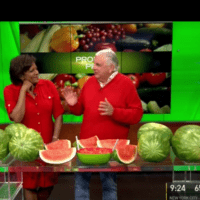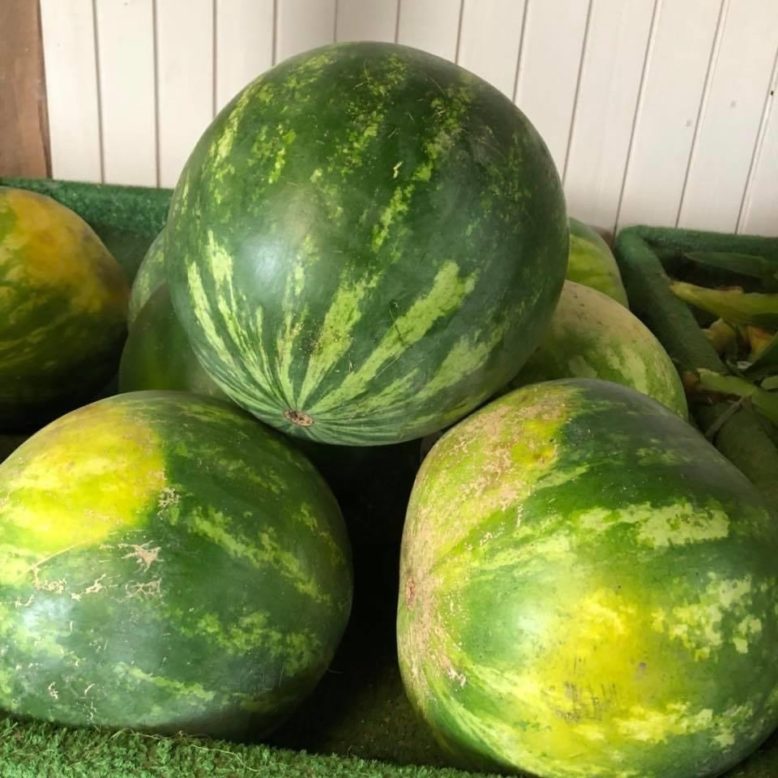While so many different fruits and vegetables trigger special memories from throughout my life, watermelon takes me right back to my childhood in Bergen County, when my dad and I would peddle watermelons door-to-door from the back of his truck. Today, many people prefer buying sliced watermelon, but back then, everybody bought whole melons because they had big families. I remember going down to the farmers’ market in Newark on Sunday nights with Pop to load up our rack body truck with watermelons. If we were lucky, we’d be sold out by 2pm the next day, and Pop would take me and my younger brother David swimming for a couple of hours—the ultimate incentive for two little kids on those hot summer days.
Believe it or not, watermelons were also responsible for helping to launch our family business, Napolitano’s Produce in Bergenfield, in the late 1950s. Though Pop had always been in and out of the produce business, at that point he was driving a bus for the Red & Tan company in New Jersey and Mom wanted to make some extra money for our family. She ended up asking my dad to buy her a load of watermelons so that she could sell them in a lot on the corner of Washington Avenue and Liberty Road in Bergenfield. Later that day, he drove by the lot to find that Mom had sold every last watermelon! Being a good husband, Pop bought her two loads of watermelons the next day and she sold them out too. Needless to say, Pop stopped driving the bus soon after and Napolitano’s Produce was born!


All About Watermelon
Watermelons originated in Africa and are actually edible gourds that are related to cucumbers and squash. Today, 75 percent percent of the watermelon crop is produced between June and August (often sourced from Florida, Georgia, California, Texas, and locally during the spring and summer); they’re also available during the winter (imported from Mexico and Central America), though they’re more expensive and in limited supply during the colder months. As with most fruits, I recommend that people buy watermelons when the domestic crop is in season.
In the 70 years that I’ve been in the produce business, you wouldn’t believe how many different ways I’ve seen people try to determine whether a whole watermelon is ripe. Some thump it or twist the stem to see if it will twist back. Others balance straw on a melon to see if the straw will rotate, and I’ve even seen people submerge a melon in a bucket of water to see if it will float. In the end, the best and most reliable way to tell is to turn the watermelon over and look for a yellow belly, which means that it has maturity. Then slap the melon and listen for a hollow thump. Finally, look at the stem end—if the stem is shrunken, shriveled, or decayed, the melon is ripe. If the stem is missing, the watermelon is too ripe and will be mealy, dark, and not fresh. If the stem is green, the watermelon is too green and not ripe.

A display of watermelons at Hauser Hill Farms in Old Bridge. Photo courtesy of Hauser Hill Farms
8 Fun Facts About Watermelon
—The first recorded watermelon harvest occurred in Egypt nearly 5,000 years ago.
—There are over 1,200 varieties of watermelon grown in nearly 100 countries around the world.
—By definition, watermelon is both a fruit and a vegetable.
—Watermelons are 92 percent water.
—High in Vitamins A and C, watermelon has just 85 calories per serving.
—Watermelons are extremely high in lycopene, the pigment that gives many fruits their bright red color, and they contain more of this compound than raw tomatoes. In addition to being a powerful antioxidant with anti-cancer properties, lycopene can relieve muscle soreness and is also believed to be effective in helping to prevent asthma. The redder the watermelon, the more lycopene it contains.
—Watermelons typically weigh anywhere from 5-30 pounds, with the smallest varieties weighing as little as two pounds and the heaviest—as recorded by the Guinness Book of World Records—weighing in at over 350 pounds.
—Seedless watermelons evolved through the natural process of hybridization and now account for 85 percent of the watermelons sold in the U.S.
Watermelon: A Farmer’s Eye-View

John Hauser, owner of Hauser Hill Farms in Old Bridge, tends to watermelon plants in his field. Photo courtesy of Hauser Hill Farms
At Hauser Hill Farms in Old Bridge, “watermelon is a pretty important crop for us every year,” confirmed John Hauser, owner of the over 150-year-old, fifth-generation operation, which farms nearly 200 acres across three locations in Middlesex and Monmouth Counties. “We source watermelon from farms in Maryland, Delaware, and South Jersey through late-July, but then we sell our own from about July 25 through October,” says Hauser. Initially germinated in their greenhouse and then transplanted and grown on 2-2½ acres of their field in two plantings, “we typically sell over 1,500 watermelons over our 8-10-week season,” he says.
According to Hauser, Hauser Hill Farms grows 4-5 different kinds of watermelon—from traditional seeded
“sugar babies,” which weigh 8-10 pounds and sell for $4-$5, to crimson sweet striped melons, which weigh 14-15 pounds and sell for $6-$8, and seedless watermelons, which weigh upwards of 15 pounds and sell for $8-$10. “We also sell icebox-sized “yellow doll” watermelons, which taste similar to red varieties but which kids and families love to sample at special events and at the weekly farmers markets we sell at in Holmdel, Keyport, Rahway, Freehold, Highlands, and Red Bank,” Hauser says. “These yellow (as well as orange) watermelon varieties are great for both eating and for making drinks, and restaurants tend to favor them because they make for an aesthetically pleasing presentation.”
Whatever variety you opt for, Hauser said that you can’t go wrong with watermelon at this time of year. “Watermelon is so refreshing, is one of the easier fruits to eat, and brings up so many great memories from childhood. When I was a kid, I remember that we used to have contests to see who could spit the seeds the furthest,” says Hauser. “In New Jersey, watermelon is a standard item that goes hand-in-hand with Jersey corn, peaches, and tomatoes—as a farmer, you don’t want to be without it.
“Watermelon is a universally-enjoyed fruit that’s truly synonymous with summer.”
Storage and Preparation
Because chilling zaps the compound in watermelons that prevents spoilage, I recommend storing a whole seedless watermelon at room temperature away from direct sunlight and not refrigerating it unless it’s cut or you want to chill it for a few hours before serving.
Watermelon is great eaten on its own, but you can also purée seedless watermelon for a delicious drink, freeze the purée to make ice pops, smoothies, or sorbet, or pair sweet watermelon slices with such savory flavors as fresh mint or salty ham. Or else combine chunks or balls of watermelon with other fruits in fruit salad that you serve right in the watermelon shell, as my wife Bette likes to make for parties in the summer. I know you’ll enjoy this cool summer treat as well!
Bette’s Wonderful Watermelon Basket
Ingredients:
1 whole watermelon
2 cantaloupes, peeled, seeded, and cut into chunks or balled using a melon baller
1 honeydew melon, peeled, seeded, and cut into chunks or balled using a melon baller
½-1 pound seedless grapes
1 pint blueberries (optional)
1 pineapple, cored and cut into chunks
2 pints strawberries, hulled and cut in half
Instructions:
About 2 inches from the top, cut off a slice of the watermelon along its length to form an open “basket” and discard the slice. Using a melon baller, scoop out all of the watermelon into a large bowl. Add all of the fruit except the strawberries to the bowl and mix together. Transfer the fruit salad back into the hollow watermelon basket. Top off the fruit with the halved strawberries, cut side down. Chill before serving.
About “Produce Pete” Napolitano
With over 65 years of experience in the produce industry, New Jersey’s own “Produce Pete” Napolitano is a renowned fruit and vegetable expert, author, and television personality who’s appeared on a highly-popular segment on NBC’s Weekend Today in New York broadcast every Saturday mornings for over 27 years. For more information, visit Pete’s website.
About Susan Bloom
A contributor to New Jersey Monthly and a variety of other well-known local and national publications, Susan Bloom is an award-winning New Jersey-based freelance writer who covers topics ranging from health and lifestyle to business, food and more. She’s collaborated with Produce Pete on a broad range of articles for nearly a decade.
The post Produce Pete: A Wealth of Watermelon appeared first on New Jersey Monthly.

